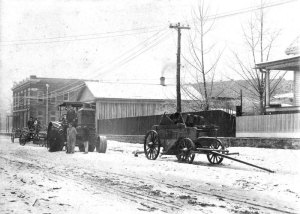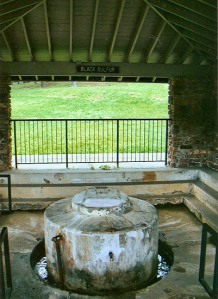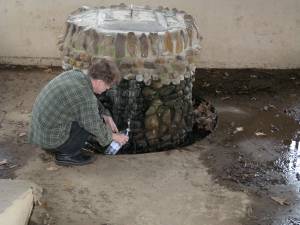Part One
When we travel, we like to visit places that have special significance to us, and we prefer places off the beaten track as opposed to tourist destinations. On our recent 4,300-mile road trip, which included playing shows in West Virginia, Virginia, and Florida, it was only natural that we decided to take a little detour through Heber Springs, Arkansas. The town is known to The Victor Mourning fans around the globe through our song, “Heber Springs Albino” (on our CD, A Handful of Locusts). Steve knew I would enjoy seeing the place that inspired him to write the song, and we wanted to collect some of the “stagnant healing water.”
Heber Springs (originally named Sugar Loaf) is the county seat of Cleburne County in north central Arkansas. It’s a sleepy town with a population of about 6,000, and it appears to have seen better days. The area has been inhabited by native people for some 10,000 years. The first white settlers arrived in the 1830s, drawn in part by the mineral springs that bubbled up from the ground in what is now the center of town.
It didn’t take long for an entrepreneur to recognize the springs’ commercial potential, and in 1838 the White Sulphur Springs Company was established for the purpose of creating a “healthful, commodious and elegant watering place” that would take its place among the hundreds of mineral spa resorts that sprang up across the country in the 19th century. Visitors flocked to the spas to bathe in and drink the supposedly healthful mineral waters, and to enjoy the wide variety of social and recreational activities that were offered for their entertainment.
Following the formula of countless mineral spas, the springs’ promoters attached their discovery to the miraculous curing of a mythical, ailing “Indian princess.” In 1886, an advertising booklet claimed that the springs offered “a sure cure for dyspepsia, headache, biliousness and hundreds of other ailments.” But Heber Springs was not destined for the success experienced at Eureka Springs or Hot Springs. The land changed hands several times through a series of complex real estate deals, there was no railroad access to bring in potential customers, and the project was never realized. By the time the Missouri & Northern Arkansas Railroad finally arrived in Sugar Loaf in 1908, the healing water craze was declining.
In 1910 the town’s name was changed to Heber Springs. The land and the springs were given to the community and became known as Spring Park. Locals continued the tradition of taking the waters in hope of curing ailments. Steve has childhood memories of seeing people filling jugs of the water at the springs and describing their various medicinal uses. There are today seven remaining springs in Spring Park that provide waters identified as White Sulphur, Red Sulphur, Black Sulphur, Arsenic, Iron, Magnesia, and Eye Water, each reputed to offer specific healing properties.
—Lynne Adele
Part Two
In 1975 I was living with my grandmother in a tiny house in Searcy, Arkansas. One afternoon I was in the living room, probably looking through the TV listings checking to see when the Little Rock station would be showing a Ritz Brothers or Wheeler & Woolsey film, when my grandmother came in. And I swear this is what I heard her say:
“Stevie, go get dressed, we’re going to the funeral home, Elvis Presley died!”
“What?”
“I said, get dressed, we’re going to Elvis Presley’s showing in Heber Springs.”
“Grandma, what are you talking about?”
“Virgie’s uncle ELLIS Presley died and we’re going to Heber to his showing. Get dressed.”
(My grandmother’s sister-in-law Virgie was a Presley and was also, tangentially, the niece of Luther Presley, author of the lyrics to the classic song “When the Saints Go Marching In”.)
So off we went to Heber Springs with my Aunt Viva at the wheel of her big forest green, late 60s Chevy Caprice. The scenery north of Searcy on Highway 16 starts getting pretty mountainous fairly quickly, and by the time we got into Heber Springs we were on the southern fringes of the Ozarks proper. Once parked in front of the funeral home in downtown Heber, I elected to wait in the car instead of going inside. (I was a headstrong adolescent in those days, always finding small ways to assert my independence.) The sun had gone down by this point, and I sat there alone looking at the exotic sight of small town neon signs. This wasn’t the first time I had been to Heber Springs, though.
About five years earlier I had come to Spring Park, the area where Heber’s springs are located, with my parents on a summer day trip. I wandered off to explore the park on my own. I was probably disappointed, given that most parks in my experience at that point either had a playground or a patch of woods to explore. This one had neither. My attention was captured, however, by a small concrete pool with scores of tadpoles swimming in it. I had never seen a tadpole before. I found a discarded paper cup and did a bit of “catch and release” tadpole fishing.
I wandered over to one of the springhouses and watched a family filling up jugs with water. The father began to lecture me politely on the different healing properties of each spring. From what I could gather, they seemed to be getting jugs of water from each different spring to have on hand to use as a healing aid should one of them suffer, say, an attack of biliousness or weakened constitution. Somehow, many years later, these memories resurfaced as fragments in the song, “Heber Springs Albino.”
—Stephen Lee Canner



